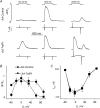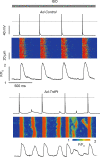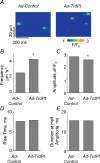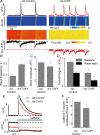Protein protein interactions between triadin and calsequestrin are involved in modulation of sarcoplasmic reticulum calcium release in cardiac myocytes
- PMID: 17569730
- PMCID: PMC2277233
- DOI: 10.1113/jphysiol.2007.136879
Protein protein interactions between triadin and calsequestrin are involved in modulation of sarcoplasmic reticulum calcium release in cardiac myocytes
Abstract
In cardiac muscle, intracellular Ca2+ release is controlled by a number of proteins including the ryanodine receptor (RyR2), calsequestrin (CASQ2), triadin-1 (Trd) and junctin (Jn) which form a complex in the junctional sarcoplasmic reticulum (SR) membrane. Within this complex, Trd appears to link CASQ2 to RyR2 although the functional significance of this interaction is unclear. In this study, we explored the functional importance of Trd-CASQ2 interactions for intracellular Ca2+ handling in rat ventricular myocytes. A peptide encompassing the homologous CASQ2 binding domain of Trd (residues 206-230 in the rat; TrdPt) was expressed in the lumen of the SR to disrupt Trd-CASQ2 interactions. Myocytes expressing TrdPt exhibited increased responsiveness of SR Ca2+ release to activation by ICa as manifested by flattened and broadened voltage dependency of the amplitude of cytosolic Ca2+ transients. Rhythmically paced, TrdPt-expressing myocytes exhibited spontaneous arrhythmogenic oscillations of intracellular Ca2+ and membrane potential that was not seen in control cells. In addition, the frequency of spontaneous Ca2+ sparks and Ca2+ waves was significantly increased in TrdPt-expressing, permeabilized myocytes. These alterations in SR Ca2+ release were accompanied by a significant decrease in basal free intra-SR[Ca2+] and total SR Ca2+ content in TrdPt-expressing cells. At the same time a synthetic peptide corresponding to the CASQ2 binding domain of Trd produced no direct effects on the activity of single RyR2 channels incorporated into lipid bilayers while interfering with the ability of CASQ2 to inhibit the RyR2 channel. These results suggest that CASQ2 stabilizes SR Ca2+ release by inhibiting the RyR2 channel through interaction with Trd. They also show that intracellular Ca2+ cycling in the heart relies on coordinated interactions between proteins of the RyR2 channel complex and that disruption of these interactions may represent a molecular mechanism for cardiac disease.
Figures







Comment in
-
An Il-lumen-ating look at ryanodine receptor modulation by disruption in triadin and calsequestrin interactions in cardiac myocytes.J Physiol. 2008 Feb 1;586(3):697-9. doi: 10.1113/jphysiol.2007.147751. Epub 2007 Nov 29. J Physiol. 2008. PMID: 18048447 Free PMC article. No abstract available.
Similar articles
-
Triadin overexpression stimulates excitation-contraction coupling and increases predisposition to cellular arrhythmia in cardiac myocytes.Circ Res. 2005 Apr 1;96(6):651-8. doi: 10.1161/01.RES.0000160609.98948.25. Epub 2005 Feb 24. Circ Res. 2005. PMID: 15731460
-
Abnormal interactions of calsequestrin with the ryanodine receptor calcium release channel complex linked to exercise-induced sudden cardiac death.Circ Res. 2006 May 12;98(9):1151-8. doi: 10.1161/01.RES.0000220647.93982.08. Epub 2006 Apr 6. Circ Res. 2006. PMID: 16601229
-
Modulation of cytosolic and intra-sarcoplasmic reticulum calcium waves by calsequestrin in rat cardiac myocytes.J Physiol. 2004 Dec 1;561(Pt 2):515-24. doi: 10.1113/jphysiol.2004.073940. Epub 2004 Oct 14. J Physiol. 2004. PMID: 15486014 Free PMC article.
-
Modulation of ryanodine receptor by luminal calcium and accessory proteins in health and cardiac disease.Cardiovasc Res. 2008 Jan 15;77(2):245-55. doi: 10.1093/cvr/cvm038. Epub 2007 Oct 15. Cardiovasc Res. 2008. PMID: 18006456 Review.
-
New roles of calsequestrin and triadin in cardiac muscle.J Physiol. 2009 Jul 1;587(Pt 13):3081-7. doi: 10.1113/jphysiol.2009.172098. Epub 2009 May 18. J Physiol. 2009. PMID: 19451205 Free PMC article. Review.
Cited by
-
Store-dependent deactivation: cooling the chain-reaction of myocardial calcium signaling.J Mol Cell Cardiol. 2013 May;58:77-83. doi: 10.1016/j.yjmcc.2012.10.008. Epub 2012 Oct 27. J Mol Cell Cardiol. 2013. PMID: 23108187 Free PMC article. Review.
-
Triadin regulation of the ryanodine receptor complex.J Physiol. 2015 Aug 1;593(15):3261-6. doi: 10.1113/jphysiol.2014.281147. Epub 2014 Oct 20. J Physiol. 2015. PMID: 26228554 Free PMC article. Review.
-
The role of luminal Ca regulation in Ca signaling refractoriness and cardiac arrhythmogenesis.J Gen Physiol. 2017 Sep 4;149(9):877-888. doi: 10.1085/jgp.201711808. Epub 2017 Aug 10. J Gen Physiol. 2017. PMID: 28798279 Free PMC article. Review.
-
Endoplasmic reticulum-mediated signalling in cellular microdomains.Acta Physiol (Oxf). 2017 Jan;219(1):162-175. doi: 10.1111/apha.12675. Epub 2016 Apr 5. Acta Physiol (Oxf). 2017. PMID: 26973141 Free PMC article. Review.
-
Ryanodine receptor luminal Ca2+ regulation: swapping calsequestrin and channel isoforms.Biophys J. 2009 Oct 7;97(7):1961-70. doi: 10.1016/j.bpj.2009.07.030. Biophys J. 2009. PMID: 19804727 Free PMC article.
References
-
- Beard NA, Laver DR, Dulhunty AF. Calsequestrin and the calcium release channel of skeletal and cardiac muscle. Prog Biophys Mol Biol. 2004;85:33–69. - PubMed
-
- Bers DM. Macromolecular complexes regulating cardiac ryanodine receptor function. J Mol Cell Cardiol. 2004;37:417–429. - PubMed
-
- Fill M, Copello JA. Ryanodine receptor calcium release channels. Physiol Rev. 2002;82:893–922. - PubMed
-
- Franzini-Armstrong C, Protasi F. Ryanodine receptors of striated muscles: a complex channel capable of multiple interactions. Physiol Rev. 1997;77:699–729. - PubMed
Publication types
MeSH terms
Substances
Grants and funding
LinkOut - more resources
Full Text Sources
Other Literature Sources
Molecular Biology Databases
Research Materials
Miscellaneous

